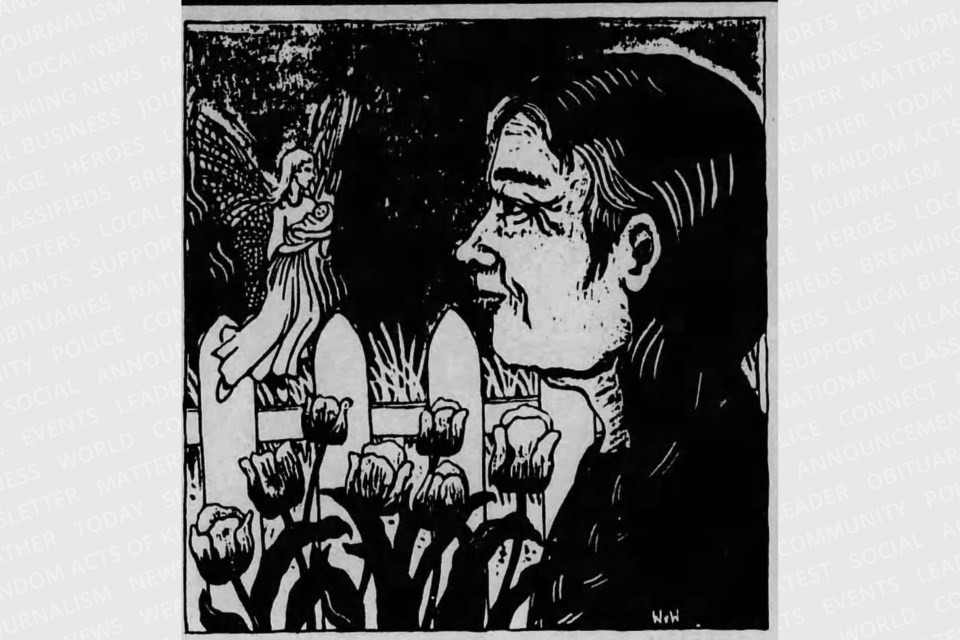From the archives of the Sault Ste. Marie Public Library:
Remember the bedtime story about ‘The Fairy’s Tulips’?
The folktale comes from Devonshire, a county in the southwest of England, known today as Devon. As the story goes, this lady lived in a secluded cottage that had a tulip garden alongside it. However, the lady’s tulips “stayed fresh and tall all through May, June and July, while all the other tulips in the area had long since died and left only bent stems and fallen leaves” (Sault Star, 25 May 1993, p. 23).
This, as you can imagine, eventually sparked the interest of the woman who “was more interested in birds than flowers, and more interested in flowers than people” (p.23).
The solitary lady with the ‘magical’ garden was an avid birdwatcher. In the twilight of one evening, she noticed something fluttering in her periphery and thought it may be a bird. However, to her surprise, “[i]nside the black centre, circled by yellow powder from the stamens, was a sleeping fairy baby, about the size of a penny” (p.23).
The woman, being a person who loved nature, was pleased at her discovery and proceeded to bring a treat for the fairy that used her tulips as a cradle in the evenings. Upon meeting the fairy, they exchanged pleasantries and told the secret as to how her tulips lasted so long into the season.
The mother of the baby fairy said, “We love your tulips, and help them to grow. Because you have left them for us, we will give them a delicious scent” (p. 23). From that day on, the tulips in the lady’s garden had a lovely smell to them, despite tulips usually being scentless, drawing the attention of those in the area.
Just like this folktale, tulips, being one of the first flowers to appear in spring, drew a noticeable amount of attention from our local newspaper throughout the years. Two columns that shared information about the maintenance of the spring flower were ‘Today’s Garden-Graph’ and ‘Gardening in Algoma.’
In the column ‘Gardening in Algoma,’ Ken Ingle urged prospective gardeners to choose tulip bulbs for their fall plant list. In the August 29, 1966, edition of the Sault Star, Ingle stated, “a tulip is not just a tulip: it’s a member of one of at least 13 different classes” (p.7).
The columnist went on to dispel the notion that a ‘tulip is just a tulip’ as he reviewed the different classes of tulip, including specifications as to how each were unique, including colour, shape, size, and times in which they bloomed to name a few.
‘Today’s Garden-Graph’ was a column supplied by the Central Press Association and written by Dean Halliday. In this series of columns, Halliday reviewed best practices for planting tulip bulbs and how to avoid some of the issues that may arise. One such issue that was discussed in the September 07, 1948, issue of the Sault Star, was called ‘Tulip Fire,’ which is categorized by “leaves and flowers [becoming] spotted and ‘burned’ in appearance, and the bloom often completely destroyed” (p.12). By this description, it is obvious that tulip lovers would want to prevent a ‘Tulip Fire.’ To prevent the concern, Halliday suggested that “tulips which have grown in one place for several years should be planted in a different location” (p.12).
Whether it was the ‘Red Emperor’ or ‘double tulip,’ certain practices were recommended when planting bulbs.
It was suggested to “cover the bed or border with hay, straw, leaves or other litter” (p.12).
However, the author cautioned to “not mulch them…until after the first killing frost” and to “plant tulip bulbs some six inches deep” (Sault Star, October 27, 1947, p.14).
The mulch was used to protect the bulbs from the harsh winters, but you wanted to wait until the ground established a solid top layer to prevent unwanted critters from confiscating your bulbs. Halliday also suggested to “give the beds, where they have been planted a thorough soaking immediately after planting. This settles the soil firmly about the bulbs and induces quick root growth” (p.14).
The majority of Halliday’s ‘Today’s Garden-Graph’ columns were accompanied by a diagram to display the concepts or tulip varieties that were discussed.
Another fun fact about tulips stems from where they originated. Tulips “originated in Arabia and got their names from the Arabic word for turbans” (Sault Star, May 25, 1993, p.23).
Each week, the Sault Ste. Marie Public Library and its Archives provide SooToday readers with a glimpse of the city’s past.
Find out more of what the Public Library has to offer at www.ssmpl.ca and look for more "Remember This?" columns here.
References
- Sault Star “BEDTIME STORY: The Fairy’s Tulips”. May 25, 1993, p.23.
- Sault Star “Meet the World’s Largest Tulip”. October 27, 1947, p.14.
- Sault Star “How to Prevent ‘Tulip Fire’”. September 07, 1948, p.12.
- Sault Star “Columnist Recommends Bulbs for Fall Planting”. August 29, 1966, p.7.
